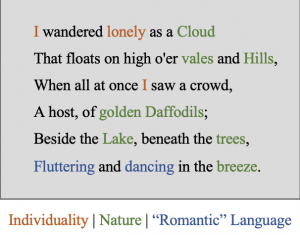Danae Echeverria
ENGL 301 98A
June 8th, 2022
Lesson 1.3 – Definitions
Dear Writing Team,
This assignment aims to explain the term romanticism to nontechnical readers by providing three different definitions: (1) a parenthetical definition, (2) a sentence definition, and (3) an expanded definition. The reading situation entails an English Literature student explaining the different literary movements that originated in Europe to their science-oriented friend.
Term: Romanticism
Parenthetical definition:
Romanticism was an artistic eighteenth- and nineteenth-century movement that emphasized nature and subjectivity (it fixated on how individual imagination and intuition are of importance in understanding the natural world).
Sentence Definition:
Romanticism was an intellectual movement in literature and art that originated from the late 18th and 19th centuries and is characterized by the individuality of the creator’s expression, specifically highlighting the role of emotions and subjective experience with nature rather than logic and rationality.
Expanded Definition (4):
1. Etymology:
The word romantic (ism) derives from its original old French stem, romanz, referring to a literary work produced in the vernacular and relating to a romant, an imaginative work. In the 18th century, the term developed in close association with romantique, connoting a tendency towards romantic ideas, in which case the word-forming element “ism” highlights its status as an artistic movement. The synonymous usage for romantic shows that it is an example of a term which holds a variety of meanings in accordance to personal and individual needs.
2. History:
Romantic art and literature emerged as the 19th century movement that began in Germany and developed in Europe as a response to the Age of Enlightenment. Romanticists felt that logic and reason was overemphasized during the Industrial revolution, and were dissatisfied with the existing culture of the Enlightenment. After the French Revolution that caused a relevant social change in 1789, Romanticism was introduced through a new philosophy about new forms in art and thought, placing importance on attributes of human experience such as aesthetic beauty, irrational emotions, and freedom of expression.
Below are two examples of works from the Romantic era:
Example #1: “I Wandered Lonely as a Cloud” by William Wordsworth (1802)
Wordsworth’s poem is written from a subjective point of view as it details the narrator’s encounters with wildflowers beside the lake. It is considered a classic work for describing human involvement with the natural world through simple and elegant language.

Example #2: Wanderer Above the Sea of Fog by Caspar David Friedrich (1818)
Friedrich’s artwork depicts a man looking beyond a dense sea of fog, suggesting his diminished power in the vast magnitude of life. Art historians state that this work is a portrayal of Friedrich’s emotional state, one that depicts “ideas of roaming and infinity, of the imperfection of emotions and the soul” (artincontext).

3. Negation:
Romanticism was an intellectual movement in literature and art that appeals to the emotions rather than to the intellect by emphasizing the individuality of the creator’s expression and their relationship to the natural world: it steers away from—and revolts against—the neoclassicism movement that evoked emotional restraint, order, logic, and an emphasis of form over content.
4. Analysis of Parts:
Romanticism was an art and literature movement spanning roughly from 1790-1850. Any list of particular characteristics of romantic works includes (but are not exclusive to):
1. An emphasis on the natural world as a symbol of power or infinite beauty that deserves detailed descriptions of its glorifying qualities by using literary techniques such as pathetic fallacy.
2. Individual experience and spirituality as the focal points of the work—themes of isolation and solitude are encouraged as being necessary for spiritual and artistic development, placing high value on the emotions and creative impulses of artists and writers who are guided by their personal relationships with the world.
3. The idealized portrayal of women through the concept of female beauty, presenting female characters as innocent, pure, and beautiful with the sole purpose of being love interests to their male counterparts.
Works Cited
Harper, Douglas. “Etymology of Romanticism.” Online Etymology Dictionary, www.etymonline.com/word/romanticism. Accessed 8 June 2022.
Motta, Cristina. “Romanticism: History of Romanticism.” USEUM Beta, 2012, useum.org/Romanticism/History-of Romanticism. Accessed 8 June 2022.
Somers, Jeffrey. “Romanticism in Literature: Definition and Examples.” ThoughtCo, 2019, www.thoughtco.com/romanticism-definition. Accessed 8 June 2022.
Leave a Reply